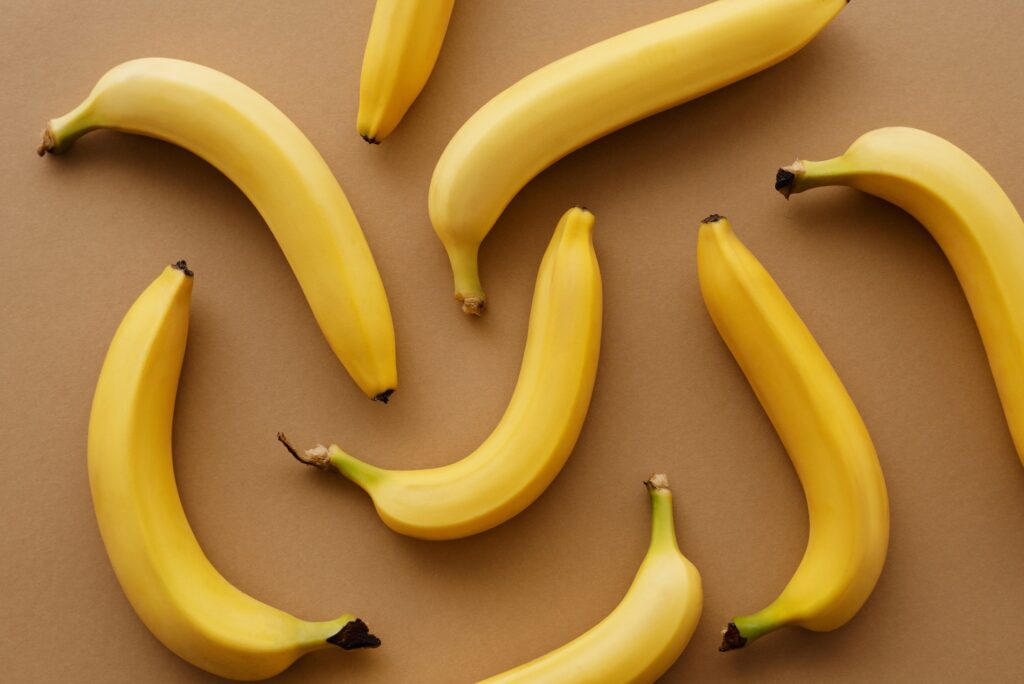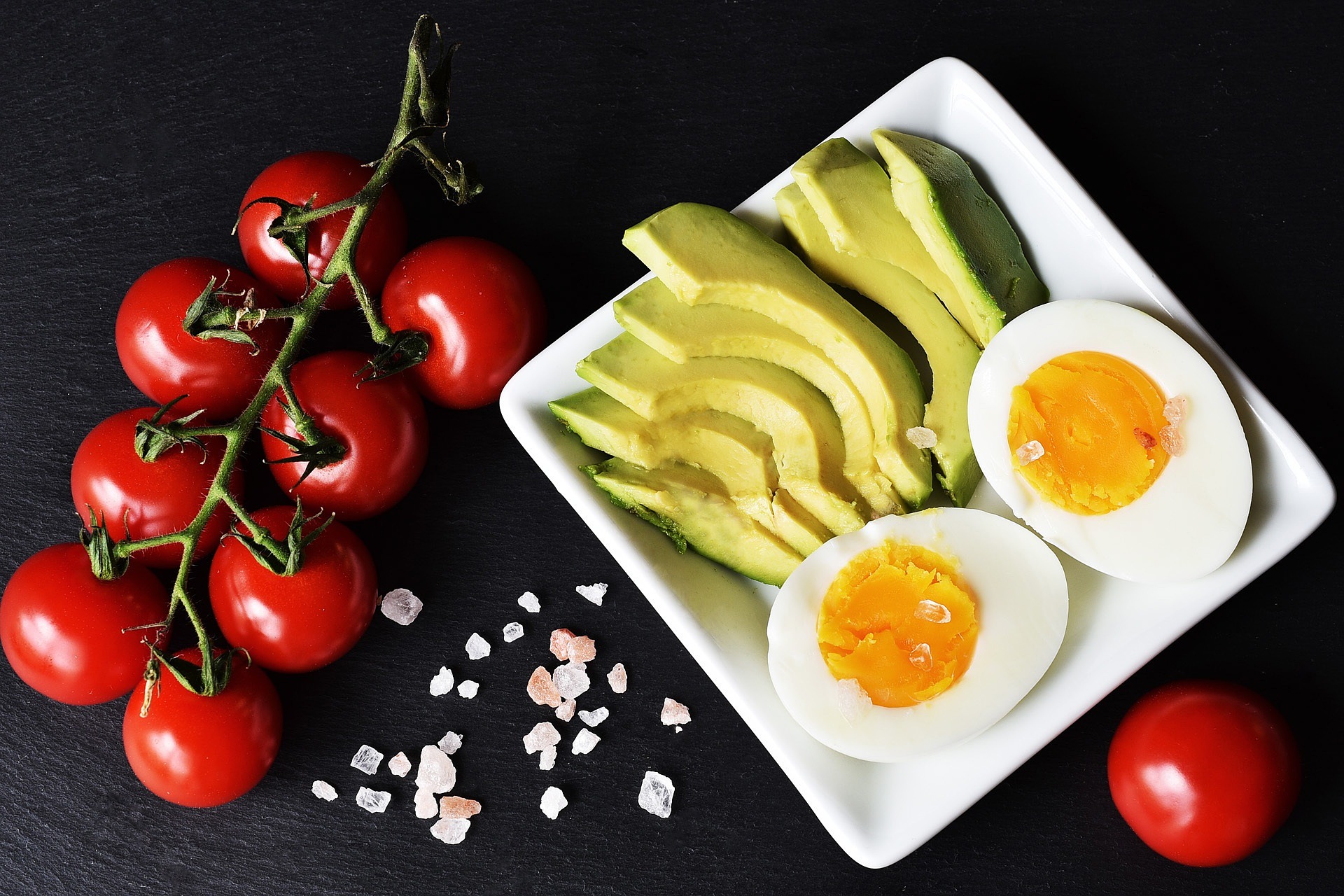3-Bullet Summary
You’ll benefit more from reading the article the whole way through. But, if you’re pressed for time, here’s a condensed version of The 8 Essential Foods for Your Student Shopping List:
- Creating a student shopping list that’s cheap and healthy is really hard. This is because we’re never taught what to eat to optimise our student lifestyles.
- The best way to structure a student shopping list is to centre it around foods that combat the key nutrient deficiencies that most students have.
- There are 8 essential foods every student should add to their shopping list: fatty fish, avocados, bananas, eggs, nuts (almonds, cashews, pistachios and Brazil Nuts), unprocessed red meats, dark green vegetables and potatoes.
“Why Is Shopping So Hard?”
It’s that time of the week again: the weekly supermarket stock up. “This time, I’m choosing some healthy foods”, you declare with intention. You draw red crosses through the images of Doritos and Pot Noodles drifting in your mind.
The wheels of the trolley roll unevenly. One’s a little bit stuck, clicking and creaking like an unoiled hinge. You gaze ahead, into the vast array of shelves and fridges.
In the middle of the store, you see stacks of cereal, pasta, bread and rice, as well as various sweets, cakes and crisps. To the store’s edges, you spot counters dedicated to meat, fish, fruits and vegetables.
There’s just so much choice.
Almost instantly, you’re overwhelmed. You came in with the desire to pick out some healthy foods for the week, but now you’re questioning yourself. “Is broccoli healthy? What about chicken strips? Eggs? Tortillas?” ponders your brain frantically.
It doesn’t help that everything you’ve ever read or heard online has given you conflicting information. Somehow the same foods that boost your brainpower and lifespan also give you cancer.
In desperation, you dart to the middle of the store — where all the goodies hide. Colourful packaging meets your eyes instantly.
Your brain’s whispering to you. It’s convincing you to put that box of sugary cereal into the trolley. Maybe that pastry, too. Perhaps also that bag of crisps. Your original mission — to pick out some healthy foods — is in jeopardy.
You’re trying to fight your brain, but you don’t want to spend all day in the supermarket. You’ve hit a roadblock.
Something so easy on paper — shopping for good food — is so hard in practice.
Introduction
I used to be like that person above. I always used to panic in the supermarket and spend hours browsing through the maze of aisles for healthy foods.
However, once I did some research into nutrition and discovered the foods that I, as a student, actually needed to eat to improve my energy levels, brain function and general health, I became more confident in the supermarket.
In fact, I discovered that there exists an ideal student shopping list.
Once I made this realisation, I became laser focused and developed a proper action plan to follow.
Guess what happened?
I ended up spending way less time in the supermarket and feeling so much better in my day-to-day life. My workouts were better, I was more focused during my study sessions and I was energised to work for longer than ever before. It was a physical and mental health transformation — one that came from a few basic, cheap, delicious foods that I will be sharing with you in this article.
Before we get to the foods however, there’s something really important you should know about…
Common Student Dietary Deficiencies
See, the reason the foods on this list will transform your life isn’t because they’re magical. Instead, it’s because they contain essential nutrients that you’re very likely to be deficient in.
Nutrients are basically the building blocks of life that you get from your diet. The more deficiencies you have, the worse your body functions.
There are three main types: water, macronutrients (proteins, fats and carbohydrates) and micronutrients (vitamins and minerals). It’s very unlikely you’re deficient in water, all three macronutrients, and every micronutrient, because you’d be dead.
However, the body can survive (suboptimally) without certain essential macronutrients and micronutrients. If all of a sudden humans dropped dead after being slightly deficient in manganese, for example, we probably wouldn’t have made it far as a species.
In turn, it is super common to see deficiencies amongst people who don’t eat foods rich in nutrients, and students are one of these populations. Although your dietary needs may vary, there are certain nutrients that you have a very high likelihood of being deficient in:
- Omega-3 fatty acids — In a 2023 study of Middle Eastern students (who tend to eat healthier than Western students), 97.9% of subjects ranked below 4% on the omega-3 index, which deems 8% a sufficient level1.
- Vitamin D — Research has shown that almost 95% of students have inadequate Vitamin D intakes2.
- Potassium — In the same study cited above, 95% of students were also deficient in potassium.
- Magnesium — A Brazilian research team found that 42% of students are deficient in magnesium3.
- Vitamin E — 34.5% of students in a 2021 paper were deficient in Vitamin E4. The researchers also found that no students met the threshold for adequate vitamin E intake. Every student was therefore at least inadequately consuming vitamin E.
- Zinc — In a sample of 881 students, two researchers found that between 33% and 50% of the students were zinc deficient5.

Student Shopping List Essentials
When I first learned about how common these deficiencies are in students, I came to a conclusion: students need to eat foods that contain these essential nutrients to reap the benefits they have.
But which foods actually contain them?
Lucky for you, I’ve put together a simple checklist of just 8 foods you should add to your weekly student shopping list. If you combine them with a diet centred around a variety of whole and minimally processed foods (i.e., foods with one or a few basic ingredients) that you enjoy, then you’ll correct any nutrient deficiencies you may have and start performing like a Strong Student.
Without further ado, let’s learn what we should actually be eating!
1) Fatty Fish
Fatty fish, like salmon, mackerel, pilchards, trout and sardines, are the number one most important food a student can consume. There, I said it.
Regarding nutrients, fatty fish are your number one go-to for omega 3 fatty acids. They’re also one of the only foods on the planet that contain vitamin D, which is most commonly synthesised from sunlight, and even contain vitamin A and zinc.
In one study consisting of more than 17,000 students, those who consumed fatty fish achieved higher grades in German and maths compared to students consuming low amounts of fatty fish6. This is because the omega-3 fatty acids found in fatty fish facilitate brain development, memory and learning7. (AKA, they’re a genuine ‘brain food’.)
Two quick notes about fatty fish, though, before moving on:
- Expensive cuts of salmon are not the only type — Tinned fatty fish is really cheap, so there’s no excuse to not buy fatty fish because it’s ‘ToO eXpEnSiVe’. If you don’t like the taste of a particular fatty fish, try another one. If you don’t like the taste of any, enter ‘how to make fish taste good’ into Google or YouTube. Find a way. I personally consume my tinned fatty fish in a simple pasta bake, and my fresh fatty fish baked in the oven with some salt, pepper and olive oil.
- Don’t consume more than 3 portions per week as a male, or 2 as a female — Fatty fish, as nutritious as it is, unfortunately also contains trace amounts of heavy metals. If you stay in the fish-consumption range specific to your sex, however, you won’t experience any issues. TL; DR: Just because fish is amazing doesn’t mean you should overdose on it.
2) Avocados
The humble avocado. Such an ugly fruit, but nonetheless one with immense value on your student shopping list.
Over 70% of the fat content present in avocados is monounsaturated. Monounsaturated fats are arguably the best source of fat (alongside omega 3) for a few reasons:
- Unlike saturated fat, they share no link with cardiovascular disease.
- Unlike omega-6 polyunsaturated fats, they aren’t prone to spoiling, oxidising, and consequently promoting inflammation.
- Unlike trans fats, they aren’t straight up toxic.
Avocados are rich in three of the common student nutrient deficiencies listed before: vitamin E, potassium and magnesium. Moreover, they’re a powerhouse when it comes to vitamins B, C and K, and they’re high in fibre, which is essential for gut and brain health8.
As a bonus, avocados are also high in a plant compound called lutein, which contributes to eye health and has been linked with improved brain function, which students especially need9.
Simply put, avocados should be a staple source of fat in your diet. (Yes, this means that guacamole is healthy. You’ve got to make it yourself, though.)
3) Bananas
If anyone ever tells you that bananas are bad because “ThEy’Re HiGh In SuGaR!” send them to this article.
Bananas are notorious for their potassium content. Because this is one of the most common deficiencies in the student population, eating bananas every day as a student is a smart idea. Bananas are also a source of magnesium (another key student deficiency), as well as vitamin C.
Moreover, bananas are a complex carbohydrate. This means that the sugar molecules they contain comprise long chains and are digested slowly. For this reason, they rank low on the glycaemic index, which is basically a list that orders foods based on how much they elevate plasma (blood) glucose (sugar) levels. Therefore, bananas are not a giant sugar bomb, as certain media outlets will make you believe.
One final point about bananas that’s super overlooked: they’re easy to digest. If you need a quick pre-workout snack, or simply some energy before an exam, then bananas are your go-to. They’re low in resistant starch, meaning they won’t be taxing to digest, nor cause you any gastrointestinal distress (bloating, gas, indigestion, etc.).
In essence, for healthy, active, hard-working pupils, bananas are batteries.
4) Eggs
When it comes to nutritional value per pound (or dollar) spent, the egg is right up there.
Like salmon, eggs are one of the only foods on earth that contain vitamin D. Eggs are also particularly high in selenium, which, when combined with foods rich in vitamin E, acts as an antioxidant that protects our bodies against inflammation and bolsters the immune system10. Moreover, eggs are one of the best sources of a B vitamin named choline, which has been shown to assist cognitive development and mental performance11.
Additionally, if you consume high-quality free-range eggs, you’ll receive omega-3 fatty acids12, which almost everyone is deficient in.
Like with salmon, however, there are a few quick disclaimers about eggs:
- Quality matters — Free-range eggs have been shown to be far more nutritious than caged eggs. One 2011 study found that pasture-raised hens’ eggs contain twice as much vitamin E, 2.5-fold more total omega-3 fatty acids, and 38% more Vitamin A compared with caged hens’ eggs13. To assess egg quality, inspect the colour of the yolk. You want that yolk to be deep yellow or orange, rather than pale. Honestly, just spend the extra pound or two and just get better eggs. Your body (and the hens) will thank you.
- Eggs are tastier and healthier when cooked at lower temperatures — When you cook food at high temperatures (i.e., pan or deep frying), eggs (as well as other foods), tend to lose nutritional value, and the polyunsaturated fats within them can oxidise and promote inflammation. Plus, you make the eggs dry and nasty. So, opt for low-temperatures when scrambling eggs, or stick to boiling, baking and poaching.
- Eat the damn yolk — All the nutrients in eggs are located in the yolk. If you throw an egg yolk out just to consume the white, then you’re missing out on a powerbomb of nutrients.
5) Almonds, Cashew Nuts, Pistachio Nuts and Brazil Nuts
Nuts are a bit like the plant version of an egg. They’re super high in so many essential micronutrients, especially vitamin E, magnesium, manganese and fibre. Nuts also contain zinc and copper, and Brazil nuts in particular provide absurdly high amounts of selenium.
However, nuts, similarly to eggs, aren’t created equal. See, nuts contain differing amounts of two compounds we don’t want a lot of in our diets:
- Phytic acid — An antinutrient that prevents the body from absorbing other essential nutrients.
- Omega-6 fatty acids — A macronutrient that is prone to oxidising and causing inflammation. Ideally, we want a 1:1 ratio of omega-6:omega-3 fatty acids, but in Western societies the ratio is more like 15:114.
The first three nuts listed — almonds, cashews and pistachios — are low in phytic acid and omega 6 relative to other nuts and have very good nutrient profiles. Make these the centre of your weekly nut consumption.
Brazil nuts are higher in phytic acid and omega 6 in comparison to the other three, but contain so much selenium that it would be silly to not have at least one serving (20g) per week.
TL; DR: go nuts for nuts, but not mainly the ones on this list.
6) Unprocessed Red Meat
Unprocessed red meats containing just one ingredient, like beef and lamb, are an essential part of a Strong Student’s diet. (Sorry vegetarians.) They’re the richest source of zinc on this list by far, and also come packed with vitamins B and A, as well as iron and selenium. Furthermore, if you can afford grass-fed red meat, then you’ll get the added benefit of dietary vitamin D.
Now, it is worth noting that diets high in red meat have been associated with cardiovascular disease and cancer15. The reasoning behind this isn’t entirely clear, although the main explanations seem to point towards the high saturated fat content of fatty cuts of red meat, especially processed red meats, like deli meats,16, and the carcinogenic compounds created when cooking red meat at high temperatures, like heterocyclic amines (HCAs)17.
Equally, though, diets lacking in unprocessed red meats have been associated with dietary deficiencies, particularly in zinc and iron18. Not eating unprocessed red meat therefore isn’t a great idea for performance optimisation.
So, we need balance. Consume unprocessed red meats no more than two times per week, aim for leaner cuts (e.g., 5% lean beef mince, which is also super cheap) and cook them via lower-temperature methods, like baking or stewing. Simple.
7) Dark Green Vegetables
When your parents told you to eat your greens as a child, they weren’t doing so to punish you. Dark greens, like spinach, broccoli, cabbage and watercress are potent sources of vitamins A, C and K, and even contain potassium, magnesium and fibre. One study showed that regular consumption of dark green vegetables even enhances the absorption of omega-3 fatty acids19, which is a huge benefit for students consuming their fatty fish.
Dark green vegetables are also ridiculously cheap. You can literally buy giant bags of frozen spinach for less than a meal deal, and then store them away to use over the course of an entire week. This means that they’re a really economical way to get in a load of nutrients.
To make consuming them easy, just add them to any savoury dish you’re preparing. Scrambling some eggs? Chuck in a handful of spinach. Making a sandwich? layer on the lettuce. Baking fish, red meat or potatoes? Chop up some broccoli, drizzle it in olive oil and slap it in the oven. Simply put, you don’t need to boil dark green veggies to mush.
8) Potatoes
To finish off the list, we have the GOAT of starchy carbohydrates: potatoes. Don’t get me wrong, rice, bread and pasta have their place in your pantry. They’re all convenient, cheap, versatile and delicious. However, when it comes to nutritional value, potatoes eclipse the competition.
They’re arguably one of the best dietary source of potassium, and contain an abundance of other micronutrients, like vitamins B and C, as well as magnesium and fibre. Sweet potatoes deserve a special shoutout because despite containing all the other nutrients that white potatoes have, they also contain a huge amount of vitamin A, which is critical for eye health and the regulation of the immune system20.
Depending on how you cook potatoes, you can also transform them into one of the most satisfying foods on the planet. For instance, boiled and skin-on baked potatoes are among the highest-ranking foods on the satiety index, which basically lists foods in order of how filling they are. Hence, if you’re prone to snacking or want to shred some excess bodyfat, make potatoes the central starchy carbohydrate in your diet.
Final Thoughts: The 8 Essential Foods for Your Student Shopping List
I *hate* online diet advice.
When I was first designing my own student shopping list, I got lost in a sea of noise. I was constantly told to not eat x food for y reason. Then, I was told that x food is the best thing for living a long and healthy life.
So, instead of just crying in the corner and opting for photosynthesis rather than food, I did my own research into the foods that I needed to be eating as a student. As I became more knowledgeable and integrated more of the foods you have just read about into my diet, I made a realisation: it’s not what I eat that matters, but rather what I get out of what I eat.
I learned that I needed to find a balance between foods I knew I could find ways to enjoy, the nutrients in those foods that I was lacking in, and price. So, as I put together my shopping list, I was constantly thinking of sustainability. In turn, I shut out flashy ‘superfood’ trends and media scaremongering.
At the end of the day, if you can’t eat a food every week for the rest of your life, then why are you eating it at all? This is the reason why the list you’ve read through today is…
- Short — There are only 8 items I want you to consume every week. The rest is up to you: the person with preferences and tastes.
- Research-backed — These foods all have good science to back their benefits.
- Flexible — Multiple items on the list have different variations. For example, within the dark green vegetable category, you’ve got a tonne of potential foods to pick from. Hence, you can experiment and find which ones you like the most and which best agree with your body.
If you take action on this guide and consume these foods every week, Your body and grades will change positively. (Unless you’re allergic to any of them, in which case, definitely seek an alternative.)
As a side note, if you find it hard to actually eat clean — you want to eat the foods on this list and improve your life but struggle to be consistent — read through the guides on goal setting and goal achievement. They provide you with step-by-step frameworks for building lasting habits.
Just remember, though, that what you put in your body shapes how you’ll feel and perform. If you fill yourself with junk, you’ll perform like junk. If you fill yourself with whole and minimally processed foods, especially the ones on this list, you’ll fuel yourself for success.







